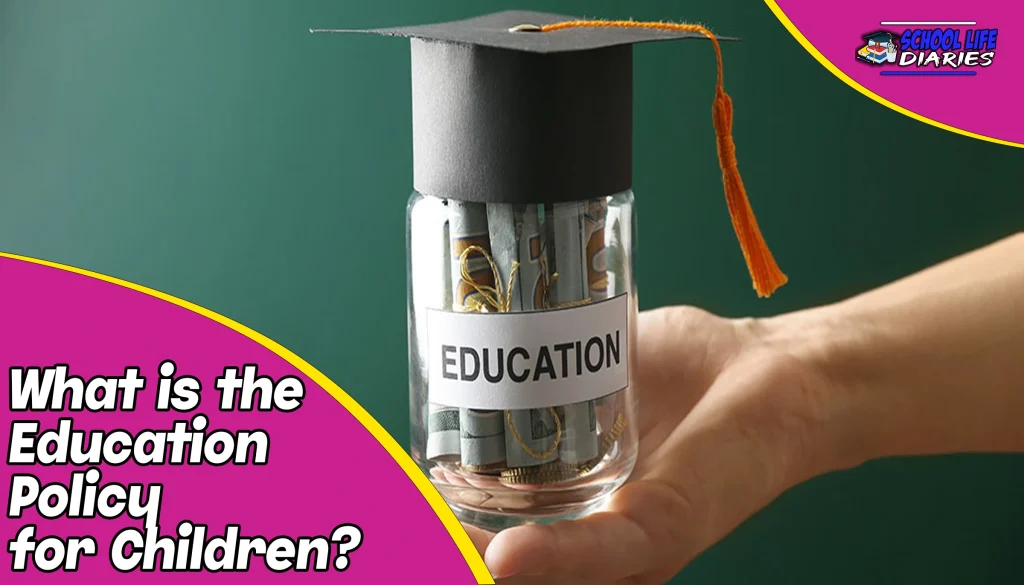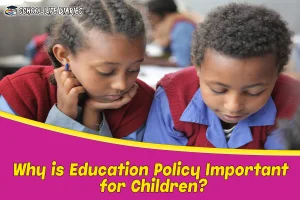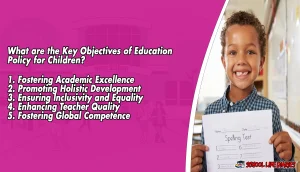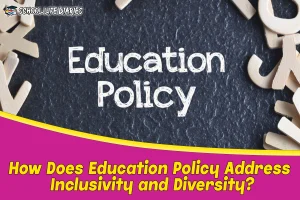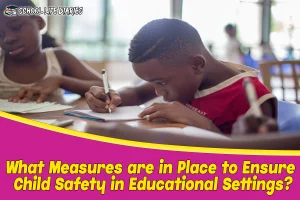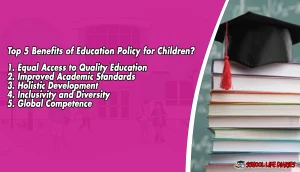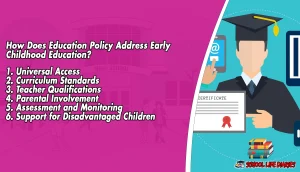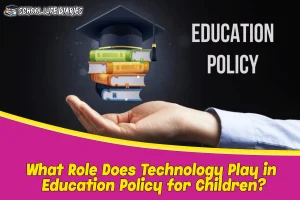Education policy for children plays a pivotal role in shaping the future of our society. In this comprehensive article, we will delve into the intricacies of this critical topic. From understanding the significance of education policy for children to exploring its key objectives, inclusivity and diversity considerations, measures for child safety in educational settings, and the top 5 benefits, this article aims to provide valuable insights.
Why is Education Policy Important for Children?
Education policy is crucial for children because it serves as the foundation for their academic journey. It ensures that every child, regardless of their background, has access to quality education. Education policy also guarantees that the curriculum is relevant and up-to-date, fostering a conducive learning environment.
Education policies create a framework for schools, teachers, and parents to work together in the best interests of the child’s education. They establish guidelines for teaching standards, learning materials, and assessment methods. Without a well-defined education policy, there would be chaos and disparities in the education system.
What are the Key Objectives of Education Policy for Children?
Certainly, let’s delve into a more detailed explanation of the key objectives of education policy for children:
1. Fostering Academic Excellence:
At the heart of education policy is the commitment to ensuring that children receive a high-quality education. This objective includes establishing rigorous academic standards, promoting innovative teaching methods, and encouraging continuous improvement in educational institutions. By setting and maintaining high academic standards, education policy aims to equip children with the knowledge and skills necessary for their future endeavors.
2. Promoting Holistic Development:
Education policy recognizes that education goes beyond textbooks and exams. It strives to nurture the holistic development of children, encompassing not just academic growth but also personal, social, and emotional development. To achieve this, education policy includes elements like creating a well-rounded curriculum that includes arts, sports, and character education, fostering critical thinking, creativity, and problem-solving skills, supporting extracurricular activities, and nurturing social and emotional intelligence.
3. Ensuring Inclusivity and Equality:
Education policy is deeply committed to inclusivity, ensuring that every child, regardless of their background, has equal opportunities to learn and grow. This objective involves eliminating barriers to access, such as discrimination and socioeconomic disparities, providing special education services for children with diverse needs, offering scholarships and financial aid, and promoting diversity and multicultural education.
4. Enhancing Teacher Quality:
Teachers are the backbone of the education system, and education policy objectives aim to support and empower educators in their mission to educate our children. This includes offering professional development opportunities for teachers, attracting and retaining highly qualified educators, providing adequate resources and support for teachers, and encouraging innovative teaching approaches to keep pace with evolving educational needs.
5. Fostering Global Competence:
In our increasingly interconnected world, education policy also focuses on preparing children to be globally competent citizens. This objective includes introducing international education programs, teaching foreign languages, promoting cultural exchange and global awareness, and emphasizing global issues and problem-solving skills. By doing so, education policy equips children to thrive in a world characterized by diversity and global interdependence.
How Does Education Policy Address Inclusivity and Diversity?
Education policy plays a crucial role in addressing inclusivity and diversity in the education system. It recognizes the importance of providing an equal educational opportunity to every child, regardless of their background, and aims to eliminate barriers that might hinder this goal. To achieve this, education policy incorporates several key strategies:
Education policy often includes provisions for special education services. These services are designed to cater to the diverse needs of students, including those with disabilities, learning differences, or other exceptionalities. By offering tailored support, education policy ensures that no child is left behind and that each student has the opportunity to thrive.
Financial accessibility is another essential aspect of inclusivity addressed by education policy. Scholarships, grants, and financial aid programs are often implemented to support students from economically disadvantaged backgrounds. Promoting diversity and multicultural education is a key component of education policy.
This involves integrating diverse perspectives and cultures into the curriculum, fostering an understanding of global issues, and promoting tolerance and appreciation for different cultures. By doing so, education policy encourages students to become global citizens who are respectful and open-minded.
What Measures are in Place to Ensure Child Safety in Educational Settings?
Ensuring child safety in educational settings is of paramount importance, and education policy plays a significant role in implementing measures to create a secure learning environment for students. These measures encompass a range of strategies and protocols: First and foremost, education policy mandates the establishment of stringent safety standards within educational institutions. This includes ensuring that school buildings and facilities are structurally sound and free from hazards.
Education policy often includes anti-bullying programs and clear guidelines on how to report and address incidents of bullying. Creating a safe and supportive social environment is essential for a child’s emotional and psychological well-being. This helps in monitoring who enters and exits the school, reducing the risk of unauthorized individuals gaining access to students. It’s a measure aimed at safeguarding children from potential threats.
Child protection policies and background checks for school staff are also essential safety measures. Education policy requires thorough screening of employees and volunteers who work closely with children. This helps prevent individuals with harmful intentions from being near students.
Top 5 Benefits of Education Policy for Children?
Education policy for children offers numerous benefits that have a profound impact on the educational landscape and the future of our young learners. Here are the top five benefits of education policy for children:
1. Equal Access to Quality Education:
One of the fundamental benefits of education policy is its commitment to providing equal access to quality education for all children. Regardless of their socio-economic background, ethnicity, or geographical location, education policy ensures that every child has the opportunity to receive a high-quality education. This not only promotes fairness but also contributes to a more inclusive and equitable society.
2. Improved Academic Standards:
Education policy aims to enhance academic standards in educational institutions. By setting and maintaining rigorous standards, children are exposed to a challenging and enriching curriculum. This benefits them by equipping them with the knowledge and skills necessary for their future academic and professional endeavors, thereby fostering academic excellence.
3. Holistic Development:
Education policy goes beyond academics; it promotes holistic development. This means that children not only focus on textbook learning but also participate in arts, sports, and character education. It nurtures skills such as critical thinking, creativity, and problem-solving, fostering well-rounded individuals who are better prepared to navigate life’s challenges.
4. Inclusivity and Diversity:
Education policy is committed to creating an inclusive and diverse educational environment. Addressing issues related to gender, race, religion, and disability, it ensures that schools are welcoming and supportive of all students. This benefits children by exposing them to a variety of perspectives, fostering empathy and understanding.
5. Global Competence:
In our increasingly interconnected world, education policy aims to prepare children to be globally competent citizens. This includes introducing international education programs, teaching foreign languages, and emphasizing global issues and problem-solving skills. Such exposure equips children to thrive in a world characterized by diversity and global interdependence, opening up opportunities for international collaboration and understanding.
How Does Education Policy Address Early Childhood Education?
Education policy recognizes the significance of early childhood education as the foundation for a child’s lifelong learning journey. Several key measures are in place within education policy to address and support early childhood education:
1. Universal Access:
Education policy often seeks to provide universal access to early childhood education. It aims to ensure that every child, regardless of their background or location, has the opportunity to participate in high-quality preschool programs. This early exposure to education helps set the stage for a successful academic career.
2. Curriculum Standards:
Education policy sets curriculum standards for early childhood education to ensure that it is developmentally appropriate and aligns with best practices in early learning. These standards cover various domains such as language development, social skills, and cognitive growth, providing a comprehensive framework for educators and caregivers.
3. Teacher Qualifications:
Early childhood educators play a crucial role in shaping a child’s learning experiences. Education policy often outlines the qualifications and training required for teachers in this field, ensuring that they are well-prepared to support young children’s development. This includes fostering their cognitive, social, and emotional growth.
4. Parental Involvement:
Education policy encourages parental involvement in early childhood education. This may include programs that provide parents with resources and guidance on how to support their child’s learning at home. By actively involving parents in their child’s education, the policy aims to create a collaborative and supportive learning environment.
5. Assessment and Monitoring:
Education policy incorporates methods for assessing and monitoring the progress of children in early childhood education. This helps identify any potential learning challenges or developmental delays early on, allowing for timely intervention and support.
6. Support for Disadvantaged Children:
Recognizing that some children may face greater challenges, education policy often includes provisions for additional support for disadvantaged children. This may involve targeted programs, subsidies, or interventions to ensure that all children have an equal opportunity to benefit from early childhood education.
What Role Does Technology Play in Education Policy for Children?
Technology plays a pivotal role in modern education policy for children, reshaping the way students learn and educators teach. One of the most significant roles technology plays is in ensuring access to education. Education policy often leverages technology to bridge the gap between students and educational resources, especially in remote or underserved areas.
Furthermore, technology is a catalyst for personalized learning, another essential aspect of education policy. Personalized learning tailors education to each student’s individual needs and pace. Education policy often promotes the use of adaptive learning platforms and educational software that can assess a student’s strengths and weaknesses, allowing educators to provide targeted support.
Technology also enhances teacher effectiveness and professional development. Education policy may encourage the use of digital tools for lesson planning, grading, and data analysis, streamlining administrative tasks and allowing educators to focus more on teaching.
Conclusion
In conclusion, education policy for children is a comprehensive framework that shapes the landscape of learning and holds the key to a brighter and more equitable future. Through a myriad of objectives and measures, education policy addresses fundamental aspects of the educational journey, ensuring that every child has access to quality education and experiences a nurturing and inclusive environment.
Education policy fosters academic excellence by establishing rigorous standards, promoting innovative teaching methods, and supporting continuous improvement in educational institutions. It promotes holistic development, emphasizing the importance of a well-rounded curriculum that includes not only academics but also arts, sports, and character education. The policy eliminates barriers to inclusivity and diversity, addressing issues related to gender, race, religion, and disability, while also providing special education services, financial accessibility, and promoting multicultural education.

